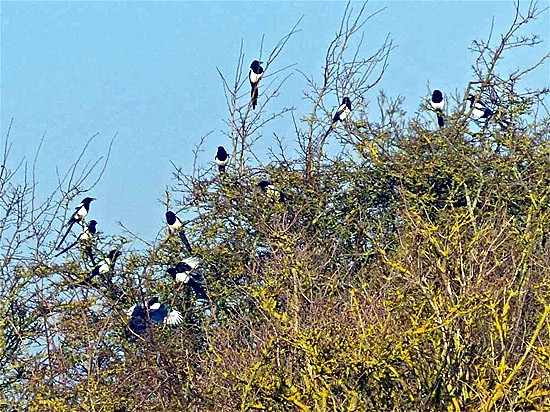
A conventicle of magpies
Photographed by Geoff Bell
WORDS BY REX NEEDLE

A conventicle of magpies
Photographed by Geoff Bell
WORDS BY REX NEEDLE
|
Of all our British birds, the magpie appears to attract more folklore than most and has been the stuff of legend, poetry and even opera, a tale by the Italian composer Gioachino Rossini having a title based on the theory that they have a habit of stealing shiny objects. But among all of this mythology is the old proverb about their numbers because magpies are thought to be solitary birds not given to flocking in large numbers:
One for sorrow, two for
mirth, three for There are variations of this with direful meanings for up to 14 magpies and rhymes can also be found in other cultures where the magpie is considered a bird of ill omen, as it was in Britain as far back as the 16th century. The magpie (Pica pica) is a member of the crow family, a large bird up to 18 inches long with iridescent black and white plumage, and is usually seen alone or sometimes in pairs but it is most unusual to see them in large numbers although there have been sightings in late winter and early spring of up to a hundred or more which ornithologists believe to be ceremonial gatherings whose purpose is not understood. This was most probably witnessed this week by walker Geoff Bell who spotted a whole flock of them perched in a hawthorn bush alongside the Car Dyke near Dyke village north of Bourne. He counted over 20 of them but some flew off before he took his picture and then all of them took to the sky as one and disappeared over the fen. What then, do we call a crowd of magpies? One of the most remarkable things about the English language is the variety of collective nouns related to the animal kingdom that all mean a group and there is not one but two such descriptions for this species which are referred to as a conventicle of magpies or a tidings of magpies, rare words for a rare sight.
Return
to Birds of Bourne Go to: Main Index Villages Index |